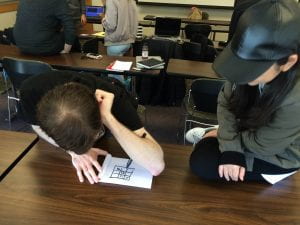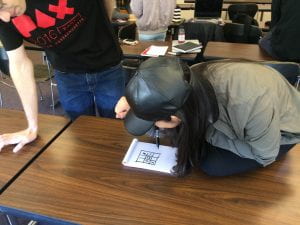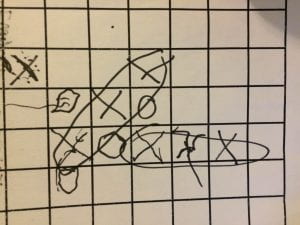Original rules:
Two players playing tic-tac-toc with additional rules:
- Each turn the player uses the marker to mark on one grid, and after that, names a body part.(left hand, right hand, left eye …whatever that makes sense and both players agrees), since then the opponent player cannot use the body part that named until the “state” resets.
- When the player was unable to play, skip that player’s turn, and resets both players’ “state”.
Final Rules:
- Two players playing a Tic-tac-toc like game on a 9×9 grid.
- Every 3 connecting (same type) marks gives the player an extra move, and chain the marks up(circle them) to indicate they will not be applied to this rule again.
- Each turn the player uses the marker to mark on one grid, and after that, names a body part.(left hand, right hand, left eye …whatever that makes sense and both players agrees), since then the opponent player cannot use the body part that named until the “state” resets.
- When the player was unable to play, skip that player’s turn, and resets both players’ “state”.
Iteration process:


Statement & Iteration:
I was inspired by the concept of the Dada movement that taking out the functionalities of objects and remake them to give new meanings and definitions, such as the readymades, the components were nonfunctional but with combining/modifying it makes a pretty interesting result. Same as that, to applied the similar abstract concept I was thinking of adding/combining two totally different game type/mechanics together, or taking some essential part of rules from each, to complete the appropriation.
The first idea I came out is adding physical elements to a strategic board game. To be more specific, I want to add parameters that were very difficult to measure (like basketball, the real-life physics were considered to be the parameter in this case) to a game that requires a lot of accurate calculation/strategic moves.(like chess)
So I came out with this additional rules, each turn players named a body part to limit the opponent, because I think this not only brings iterations and challenges to both of the players, also changes the game dynamic during gameplay.
So in order to make this more straight forward, I thought I would start with something more simple, such as a “solved game” as a base rule to appropriate on, because I thought adding new rules might add something new to this.
After the first playtest there is only one major issue is that the game is too short to play, so I changed the grid to 9×9 and added new adapted rules to the original tic-tac-toe, where the player can have 1 extra move when the player has 3 marks chained together.
The result turned to be pretty good, players are very creative on the use of mechanics, that it’s really difficult to predict what’s their strategy is because of the ambiguity of names of body parts, which is a very fun aspect of this game, and it’s very fun to watch people play with a lot of physical restrictions to use the marker.

The marks made on the paper, the up-left “X” was marked by the player holding the marker by his legs and finally marked on the wrong grid. (Sorry I didn’t take picture of the final playtest, but it looks pretty much the same as the first playtest posted above.)
